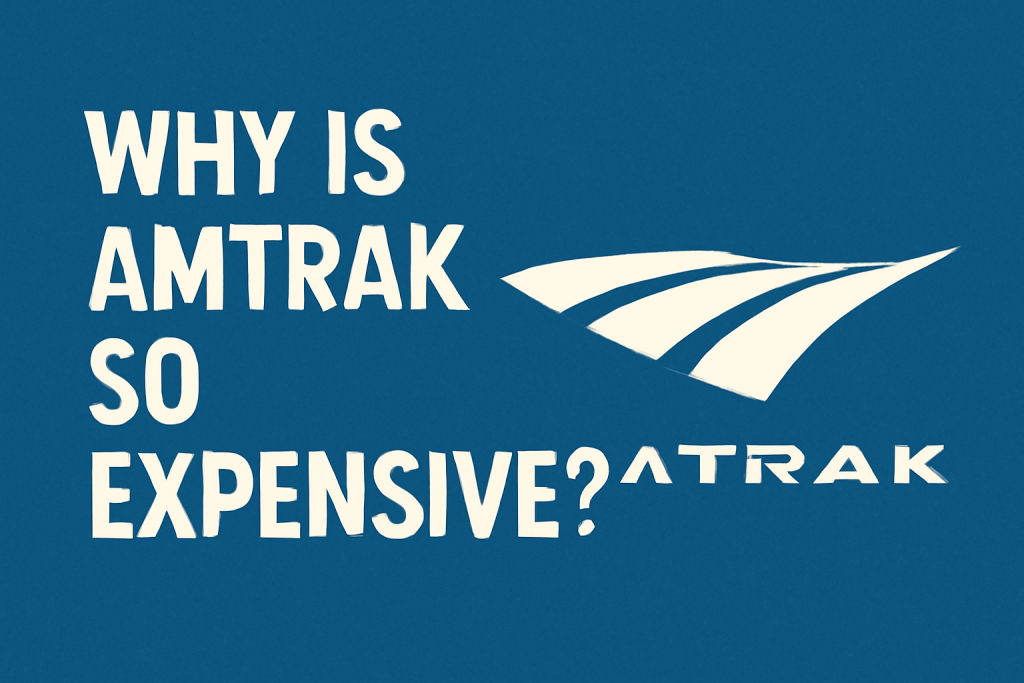Table of Contents
When I first booked a train ticket on Amtrak, I couldn’t help but wonder, “Why is Amtrak so expensive?” The price seemed a little high for a train ride, especially when compared to flights or even buses.
As someone who enjoys travel, I wanted to understand what factors contribute to the high costs of Amtrak tickets.
After digging into the details, I found several key reasons why train travel in the U.S. can be costly.
Let me walk you through the major factors and share some real-world examples that might help you better understand the price tag on your Amtrak ticket.
What is Amtrak?
Amtrak is a company that provides train services across the United States. It helps people travel long distances by train, offering both regular routes and scenic journeys.
Amtrak’s trains are a popular way to travel between cities, offering comfortable seats, food, and sometimes even sleeping accommodations on longer trips.
Why Is Amtrak So Expensive? 6 Authentic Reasons
High Infrastructure and Maintenance Costs
One of the biggest factors behind Amtrak’s high prices is the cost of maintaining and upgrading the infrastructure. Amtrak doesn’t own the majority of the tracks it operates on—freight companies own these.
This means Amtrak has to pay to use the tracks, and the costs are passed on to the passenger.
Amtrak pays nearly $500 million annually just to access and maintain the tracks, which significantly drives up the overall operational costs.
For example, on the Northeast Corridor (NEC), which is one of Amtrak’s busiest routes, Amtrak has to deal with aging infrastructure. The NEC requires billions of dollars in repairs and upgrades, which contributes to higher ticket prices.
This track-sharing agreement with freight companies is one of the reasons why U.S. train travel can feel more expensive than in other countries, where rail systems are often fully funded by the government.
Dynamic Pricing Model
Just like with airlines, Amtrak uses a dynamic pricing model. This means that ticket prices vary depending on demand, time of booking, and even the time of year.
If you book a ticket last minute, you’ll likely pay more than if you book weeks or months in advance.
In my experience, I noticed that I paid significantly more for a weekend trip than I did for a weekday journey, simply because demand was higher on those days.
For example, during peak travel seasons like summer or holidays, Amtrak fares can skyrocket. A round-trip from New York to Washington, D.C. might cost around $150 on weekdays, but during the holiday season, it could easily go up to $300 or more.
The fluctuating prices can be frustrating for passengers, but this pricing model is necessary for Amtrak to cover its costs.
Limited Competition and Monopoly in Certain Areas
Another reason Amtrak is so expensive is the limited competition on certain routes. In the U.S., Amtrak is the primary provider of intercity rail service.
Unlike airlines, which face competition from multiple carriers, Amtrak often doesn’t have any competition on routes where it’s the only rail provider.
This monopoly means there’s little pressure to lower ticket prices, and customers are left with few alternatives.
Take the Amtrak Empire Builder route, for instance, which travels between Chicago and the Pacific Northwest.
The Empire Builder is one of the few options for travelers along this route, and Amtrak takes advantage of this by setting fares higher than on more competitive routes.
Subsidy Dependence and Financial Struggles
Despite receiving federal subsidies, Amtrak has faced significant financial challenges over the years. It operates at a loss, and as a result, it must rely on ticket revenue to cover operational costs.
According to a 2024 report, Amtrak faced a $705 million operating loss despite higher ridership. The company struggles to break even, and this financial shortfall often leads to price hikes.
As an example, in 2023, Amtrak raised ticket prices on several routes to offset the costs of increased fuel prices and other operational challenges.
While some riders might understand the need for price increases, it still means that getting from point A to point B by train can cost quite a bit more than expected.
Costs of Labor and Staffing
Amtrak also has to account for the costs of its workforce. Train operators, conductors, and other staff members are highly trained professionals who demand competitive wages.
This, along with the costs of employee benefits, contributes to the overall price of the ticket.
Amtrak workers have been part of ongoing labor negotiations, and these negotiations sometimes lead to increases in wages, which in turn can drive ticket prices up.
Environmental and Comfort Factors
Amtrak trains offer a certain level of comfort, with spacious seating, dining cars, and scenic views that you simply don’t get on a plane or bus.
The luxurious nature of train travel in the U.S. also adds to the cost. Unlike budget airlines, which prioritize speed and efficiency, Amtrak offers a more leisurely, relaxed travel experience.
In fact, for a trip like the California Zephyr, which crosses the U.S. from Chicago to San Francisco, the price tag includes not just transportation but also a scenic experience.
The route passes through the Rockies and Sierra Nevada mountains, offering travelers a chance to see some of the country’s most beautiful landscapes from the comfort of their seats. This “luxury” experience is part of the reason for higher prices.
Real-World Case Study: My Amtrak Experience
I recently took a trip from New York to Boston on Amtrak’s Acela Express, a high-speed train. The cost for a one-way ticket was around $130, compared to a flight that could have been as low as $70 if booked in advance.
However, the convenience and comfort of the Amtrak train, especially with no TSA lines or delays, made it worth the price for me.
In contrast, I’ve also taken Amtrak’s Crescent route from New York to New Orleans. While the experience was comfortable, the ticket price was much higher than other forms of transportation, mainly because of the limited competition on that route.
There’s simply no other train service along that corridor, and flying wasn’t much of an option either due to the cost and inconvenience.
Tips to Save on Amtrak Fares
- Book in Advance: Ticket prices can drop significantly if you book early. You can save up to 50% on tickets by planning.
- Travel During Off-Peak Times: If you’re flexible with your travel schedule, booking tickets on weekdays or outside of peak travel seasons will likely save you money.
- Use Amtrak Discounts: Amtrak offers discounts for students, seniors, and military personnel. Be sure to check for special rates before booking.
- Consider Multi-Ride Passes: If you plan on taking multiple trips, Amtrak offers multi-ride passes that provide significant savings over individual tickets.
Final Words
Amtrak’s fares can seem high, but when you consider the infrastructure costs, limited competition, and the luxury of the travel experience, it becomes clear why prices are where they are.
While it’s not always the most affordable option, train travel can offer a unique and comfortable experience that you won’t find with other modes of transportation.
If you want to make the most out of your train journey, keep an eye out for deals, book early, and travel during off-peak times to reduce your costs.






